- 1Institute for Sun-Earth Environmental Research, Nagoya University, Nagoya, Japan
- 2Research Institute for Sustainable Humanosphere, Kyoto University, Kyoto, Japan
- 3School of Agriculture, Kibi International University, Minamiawaji, Japan
- 4National Institute of Technology, Tokuyama College, Shunan, Japan
- 5Graduate School of Engineering, Kyushu Institute of Technology, Kitakyushu, Japan
- 6National Institute of Information and Communications Technology, Koganei, Japan
Watari et al. (Space Weather, 2009, 7) found that the geomagnetically induced current (GIC) in Hokkaido, Japan (35.7° geomagnetic latitude (GML)), is well correlated with the y-component magnetic field (
Key Points
1. The geomagnetically induced currents in Hokkaido, Japan (35.7° GML), are correlated with By (cc > 0.8) for short periods (T < 1 h), while the correlation is poor (cc < 0.3) for long periods (T > 6 h).
2. The GICs with periods of 1 min to 24 h are well correlated with the electric field, Ex, induced by By in the semi-infinite one-layer conductivity model (cc > 0.85) and two-layer model (cc > 0.95) composed of highly conductive upper layer.
3. The strong By dependence of the GIC is also observed at lower latitude in Japan (25.3° GML) with cc > 0.85.
4. The By dependence of the midlatitude GIC may be associated with the ionosphere-ground currents transmitted by the TM0 mode waves in the earth-ionosphere waveguide from high latitude to the equator.
Introduction
Geomagnetic disturbances have been known to induce electric fields on the surface of the Earth, which create a potential difference between transformers in the power transmission line system. The potential difference drives electric currents [geomagnetically induced currents (GICs)] in the power lines through the Earthing lines of the transformers (Pirjola, 1983). The GIC is a quasi-steady current, compared to the frequency (50 Hz or 60 Hz) of the power system, and has the larger magnitude at higher latitudes, particularly at the auroral latitudes where the auroral electrojets cause large-amplitude disturbances in the northward magnetic field (
The GIC is derived from formula relating the GIC and the surface electric field;
On the other hand, it was reported that the GIC is much more closely related to time derivatives (dB/dt) than B (deflection from the pre-event value) (Viljanen, 1997; Trichtchenko and Boteler, 2006) and the GIC has been evaluated by quite a few papers from dB/dt using the Faraday’s law (Viljanen, 1997; Pirjola, 2000; Carter et al., 2016; Kozyreva et al., 2018). It should be noted, on the other hand, that dB/dt is related to the spatial derivative of the electric field, E, in the Faraday’s law. No clear correspondence between the GIC and
Watari et al. (2009) demonstrated that the middle latitude GIC in Hokkaido (35.7° GML), Japan, is not correlated with
The Hokkaido GIC has been reproduced from the ground magnetic fields using the surface impedance (Pulkkinen et al., 2010). Furthermore, Love and Swidinski (2015) reproduced the geoelectric field (GEF) measured at Kakioka, Japan (27.8° GML), from the magnetic fields at Kakioka using the convolution of dB/dt and the response of the semi-infinite one-dimensional flat Earth. Love and Swidinski (2014) solved the diffusion equation using the Laplace transformation and applied the function of
As overviewed above, there are various methods to reproduce the GIC/GEF from the surface magnetic field such as from
Derivation of the IEF from the Observed Magnetic field
Convolution Theorem
The magnetic field,
Here, we note that the impulse response is a response of the system to the external excitation in a form of the delta function,
where ∗ refers to the convolution of two functions. The convolution (2) implies that
We may write the Eq. 1 in a different form including 1/s (time integral) and s (time derivative) as
Using Eq. 3, we can write the convolution (2) in a different form as
where G(t) denotes the step response of the conductor, a response to the excitation function in a form of the unit step function,
where we start the summation from i = 1 since
IEF in One-Layer Model
The diffusion equation in the conductor is derived from the Faraday’s law, Ampere’s law, and Ohm’s law as listed below.
where
The Eq. 6 leads to the following diffusion equations for
The Laplace transforms of Eq. 7 are given by
where the initial value of By is assumed to be zero as mentioned above. Transformed solutions are obtained in the following form:
We give the unit step function for
We thus have the transformed solutions as
Substituting z = 0 for Eq. 10 and applying the inverse transformation,
Substituting (11) for (5), we obtain the IEF as
IEF in the Two-Layer Model
Using the earth-currents and magnetometer data, Owada (1972) showed that the subterranean electric conductivity at Memambetsu has a structure of three layers with depths of 8–20 km, 20–90 km, and 90–170 km and with conductivities higher in the top layer than in the lower layers. The MT method has revealed inhomogeneous distribution of the Earth’s conductivity in Hokkaido not only in the vertical but also in the horizontal directions (Satoh et al., 2000; Uyeshima et al., 2001; Uyeshima, 2007). However, since our purpose is to construct a model that is capable of reproducing the observed GIC, we pay our attention to the vertical profile of Owada (1972)’s results and construct a two-layer model with thickness, d = 20 km and
We assume the magnetic field be a fixed value at z = 0 in the same way as in the one-layer model, and the magnetic permeability is common in both layers. The Laplace-transformed solutions in the layer 1 and layer 2 are given as follows:
We give the unit step function for
We obtain
where
Under the condition,
where j refers to the number of reflections and n is chosen so that the summation approaches a steady value (n = 50 in the calculation below). Then, we have the coefficients as follows:
Substituting Eq. 18 for Eq. 13, we obtain the transformed solutions as follows:
The Laplace transform of the step response function,
Using the inverse Laplace transform,
Using Eq. 21 in Eq. 5, we obtain the IEF from the convolution,
Correlations among Observed GIC, Bx,y, and Ey,x
The GIC was measured on the grounding conductor in the transformer of the 187 kV power line systems at the Memambetsu substation of Hokkaido Electric Power Co. Inc. (35.7° GML). The direction of the power line is southwestward, and the length of the line is approximately 100 km (Watari et al., 2009). The magnetometer observations were made at the Memambetsu magnetic observatory (http://www.kakioka-jma.go.jp/en/index.html) close to the GIC measurements.
Pi2 and SC (1–10 min)
To confirm the high correlation between the GIC and By (Watari et al., 2009), we picked out a Pi2 event with the period of 1 min recorded at Memambetsu (MMB) in the morning sector (0600 MLT) and a geomagnetic sudden commencement (SC) with the preliminary impulse (PI, 1 min) followed by the main impulse (MI, 5–10 min) in the morning sector (0630 MLT). Figure 1 shows
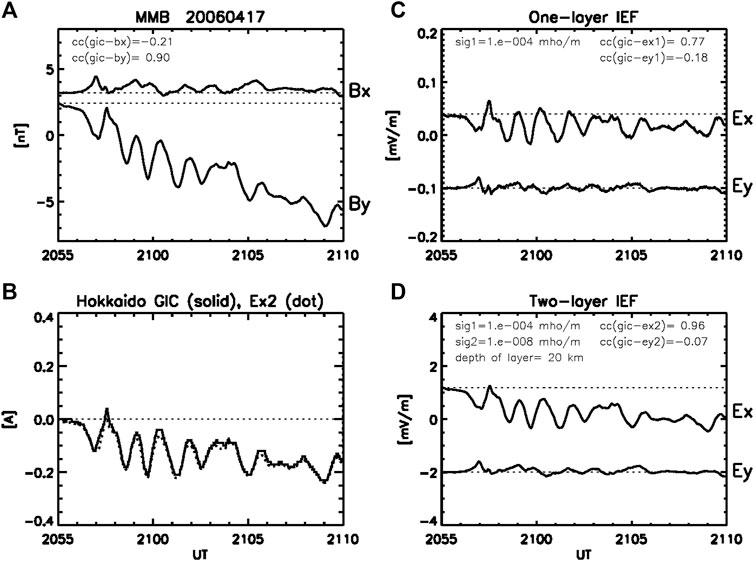
FIGURE 1. (A) X- and Y-components of the magnetic field (Bx, By) observed at the Memambetsu (MMB) magnetic observatory during the Pi2 event with the period of 1 min in the morning sector (21 UT, 06 MLT). (B) GIC observed at the Memambetsu substation of the Hokkaido Electric Company (solid curve). Ex2 scaled to the GIC is plotted with the dotted curve in the frame of the GIC, so that one can see the high correlation between the GIC and Ex2. (C, D) The induced electric fields (IEF), Ey,x induced by Bx,y at the surface of the Earth in the one- and two-layer models. Sig1 = 10–4 mho/ m in the one-layer model denotes the conductivity of the semi-infinite uniform conductor. The parameters of the two-layer model are sig1 = 10–4 mho/ m and depth = 20 km of the upper layer and sig2 = 10–8 mho/ m of the semi-infinite lower layer. The cc refers to the correlation coefficient between the GIC and Bx,y/Ey,x.
Figure 1 also shows the IEF in one-layer model,
Figure 2 shows the SC event with the positive PI followed by the negative MI in
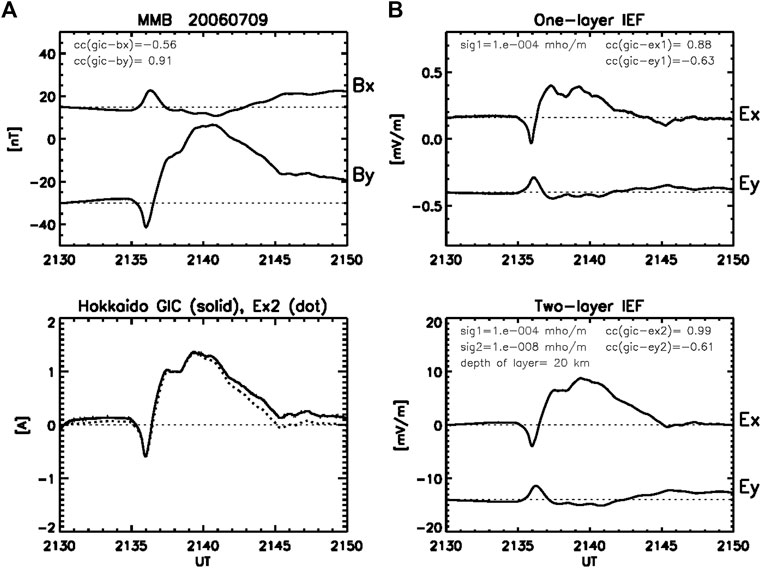
FIGURE 2. (A) Bx, By and GIC observed at MMB, and (B) Ex and Ey calculated in the one- and two-layer models for the SC event with time scales of 1–10 min observed in the morning sector (2130 UT, 0630 MLT). The parameters and formats of the plots are the same as in Figure 1.
Figure 2 (right panels) shows the IEF in one- and two-layer models. The correlation of the GIC with
Quasi-Periodic DP2 Fluctuations (30 min)
Figure 3 shows periodic fluctuations with periods of 30 min in both
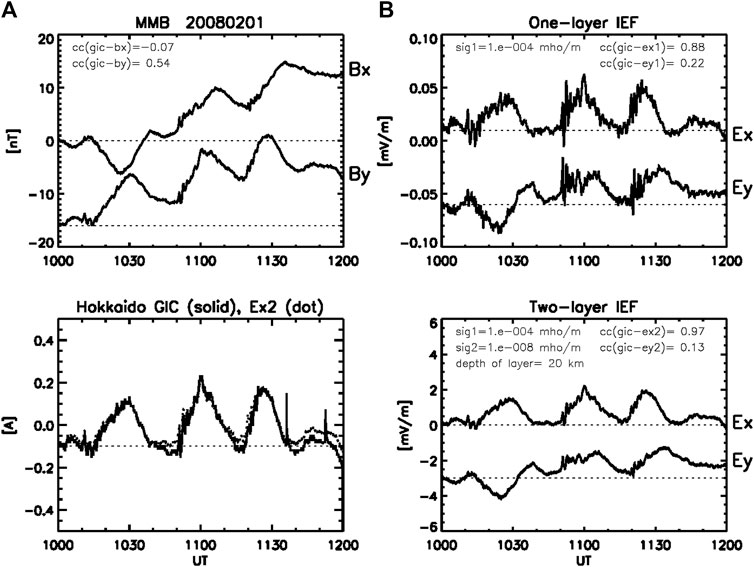
FIGURE 3. (A) Bx, By and GIC observed at MMB, and (B) Ex and Ey calculated in the one- and two-layer models for the DP2 fluctuation event with periods of 30 min in the evening sector (10-12 UT, 19-21 MLT). The parameters and formats of the plots are the same as in Figure 1.
The correlation of the GIC with
Substorm Bays (60 min)
Figure 4 shows two successive substorm positive bays in
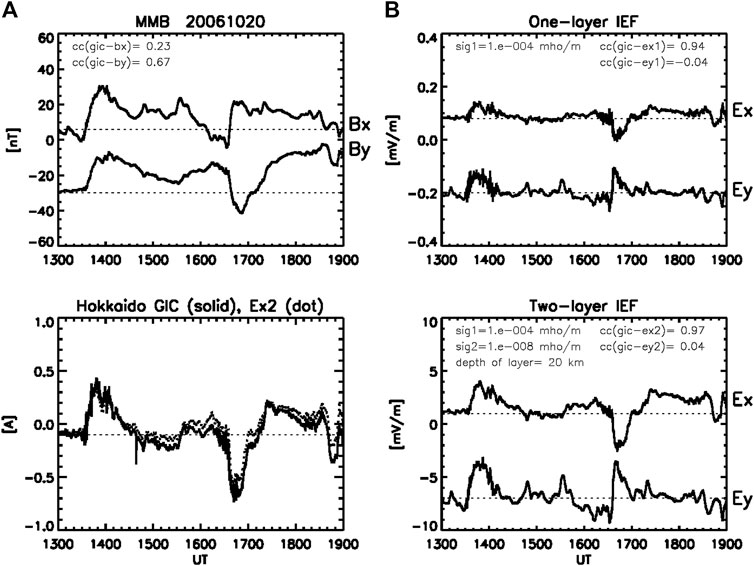
FIGURE 4. (A) Bx, By and GIC observed at MMB, and (B) Ex and Ey calculated in the one- and two-layer models for the substorm positive bay events with time scales of 60 min in the pre-midnight (14 UT, 23 MLT) and post-midnight (17 UT, 02 MLT). The parameters and formats of the plots are the same as in Figure 1.
Geomagnetic Storms (1–20 h)
Figure 5 shows a geomagnetic storm event, where
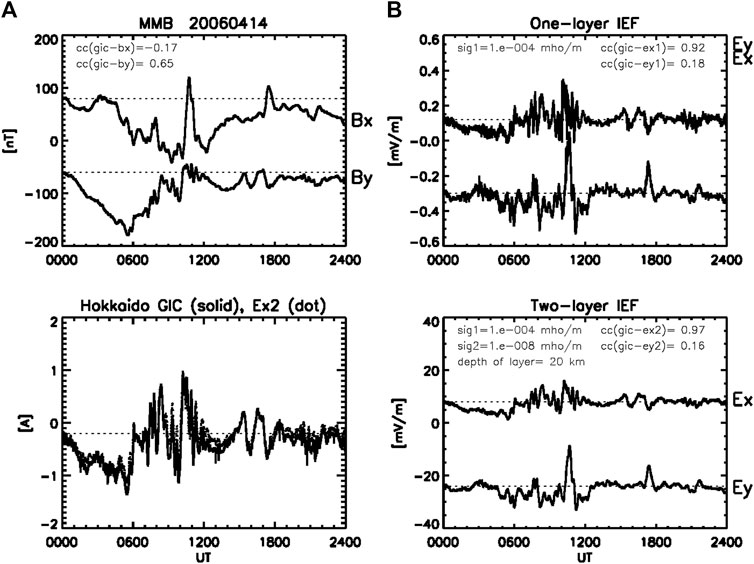
FIGURE 5. (A) Bx, By and GIC observed at MMB, and (B) Ex and Ey calculated in the one- and two-layer models for the geomagnetic storm events with the main phase (00-10 UT, 09-19 MLT) followed by the recovery phase (10-18 UT, 19-03 MLT) superimposed by the substorm positive bay (10-11 UT, 19-20 MLT). The parameters and formats of the plots are the same as in Figure 1.
Solar Quiet Geomagnetic Variations (8 h)
Figure 6 shows an example of the solar quiet geomagnetic variations (Sq). The period of Sq is 24 h, while significant changes occur over 8 h in the daytime (00-08 UT, 09-17 MLT).
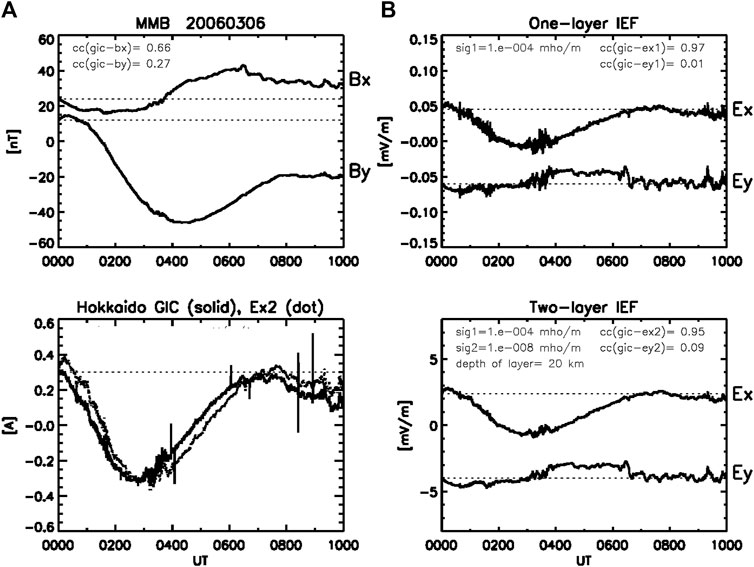
FIGURE 6. (A) Bx, By and GIC observed at MMB, and (B) Ex and Ey calculated in the one- and two-layer models for the solar quiet diurnal variations with time scales of 8 h (00-08 UT, 09-17 MLT). The parameters and formats of the plots are the same as in Figure 1.
Discussion
The GIC in Hokkaido, Japan, can be reproduced from
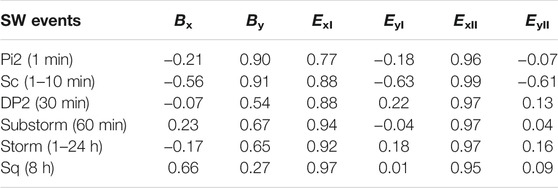
TABLE 1. Correlation coefficients between the GIC and surface magnetic fields, Bx and By and the electric field, Ey and Ex induced by Bx and By, respectively, calculated in one (I)- and two (II)-layer models for space weather (SW) events with periods ranging from 1min to 24 h.
To address this issue, we constructed the two-layer model composed of higher conductivity in the upper layer, following the previous works on the geoelectric conductivity at Memambetsu (Owada, 1972). Fujii et al. (2015), using the MT method, clarified that the apparent resistivity of the Earth increases with an increasing period of geomagnetic disturbances at Memambetsu. This result is qualitatively consistent with the two-layer model with lower conductivity in the lower layer. The two-layer model with higher conductivity in the upper layer well explains the linear relationship with B (Pirjola, 2000). As summarized in Table 1, the induced electric field in the two-layer model,
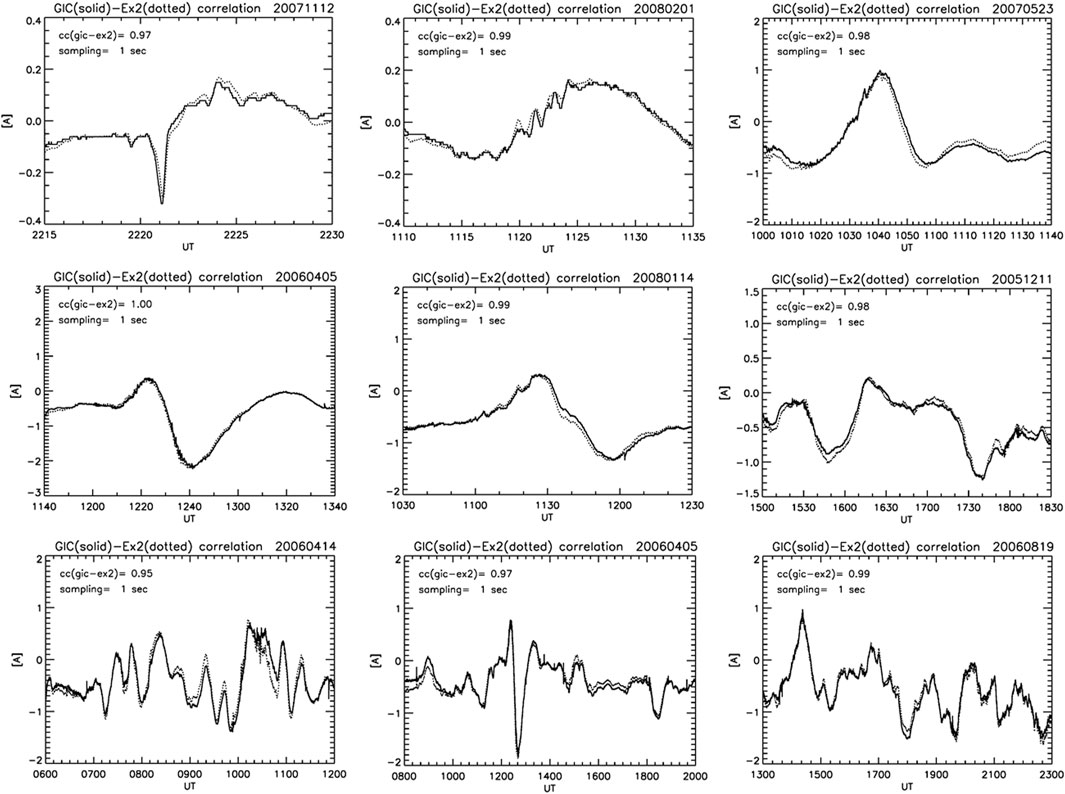
FIGURE 7. Observed GIC (solid curve) and Ex2 scaled to the GIC (dotted curve) during space weather disturbances; SC, Pi2, substorms, and storms with different time scales. The cc (gic-ex2) refers to the correlation coefficient between the GIC and Ex2, and sampling = 1 s refers to that the original 1 s sampled GIC and By data are used. Note that MLT = UT + 9.
We here check parameter dependence of the correlation coefficients (cc) in the two-layer model. Provided that the conductivities are fixed, major parameters responsible for cc are the number of reflections (n) and the depth of the upper layer (d1) in the Eq. 22. Using the DP2 event in Figure 3, we calculated cc with d1 = 20 km and different n. The cc increases as n increases such that cc = 0.94, 0.96, 0.96, 0.97, 0.97 for n = 20, 30, 40, 50, 100, respectively. We then calculated cc with fixed n = 50 and different d1. The cc increases as d1 increases such that cc = 0.94, 0.96, 0.97, 0.97 for d1 = 10, 15, 20, 30 km, respectively. Thus, we fixed n = 50 and d1 = 20 km in the two-layer model used for the calculation of the correlation coefficients.
Here, we make a brief comment on the singularity of
We next examine if we can estimate the GIC that could have occurred during the past major storms. For this examination, we fix scale factors, k1 (GIC/Ex1) = 8.0 [A/(mV/m)] and k2 (=GIC/Ex2) = 0.17 [A/(mV/m)], derived from the isolated substorm event in Figure 8. The observed GIC is well reproduced by both the one-layer and two-layer models with cc (GIC- Ex1) = 0.97 and cc (CIC- Ex2) = 0.99 as shown in the bottom left and right panels of Figure 8, respectively. For the sake of visual comparison, the observed GIC is plotted with dotted curves in each of the panels. Then, we used the scale factors, k1 and k2, to reproduce the GIC observed during the SC event (Figure 2). As shown in Figure 9, the GIC is well reproduced by the two-layer model with the same amplitude and high cc (=0.99), whereas the GIC is not well reproduced by the one-layer model with lower cc (= 0.88) and overestimation of the rapid changes at the onset of the SC. The good correlation between the GIC and Ex2 for the bay and SC events would allow us to use the scale factor k2 to estimate the GIC for the past major storms. Figure 10 shows two examples of the estimated GIC during the storms on November 6, 2001 (panel (a)) and October 30, 2003 (panel (b)). It is interesting to note that the GIC estimated for the October 2003 storm has the largest magnitude at 20 UT because of the large magnitude of By, when the storm ring current had not fully developed yet. This result suggests strong local time dependence of the GIC at MMB, which raises an important issue from the space weather forecasting point of view.
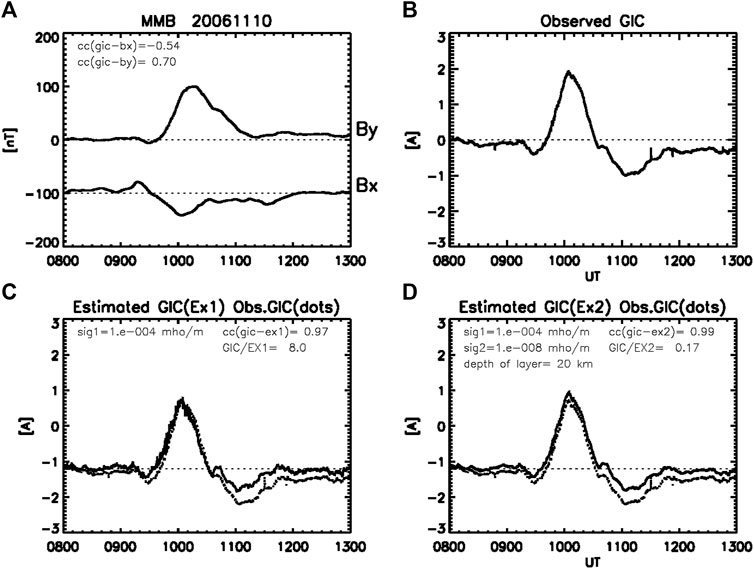
FIGURE 8. (A, B) Bx, By and GIC observed at MMB in the evening (10 UT, 19 MLT) during the substorm bay event. (C) GIC estimated from Ex1 scaled to the GIC with the scale factor, k1 = 8.0 [A/(mV/m)] (solid line) and observed GIC (dotted line). (D) GIC estimated from Ex2 scaled to the GIC with the scale factor, k2 = 0.17 [A/(mV/m)] (solid line) and observed GIC (dotted line).
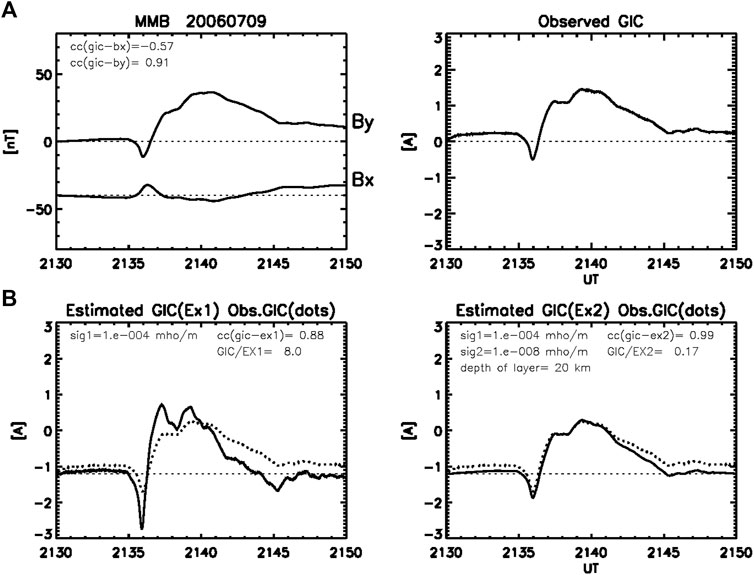
FIGURE 9. (A) Bx, By and GIC observed at MMB during the SC event same as in Figure 2. (B) GIC estimated from Ex1 and Ex2 scaled with the same scale factors as in Figure 8.
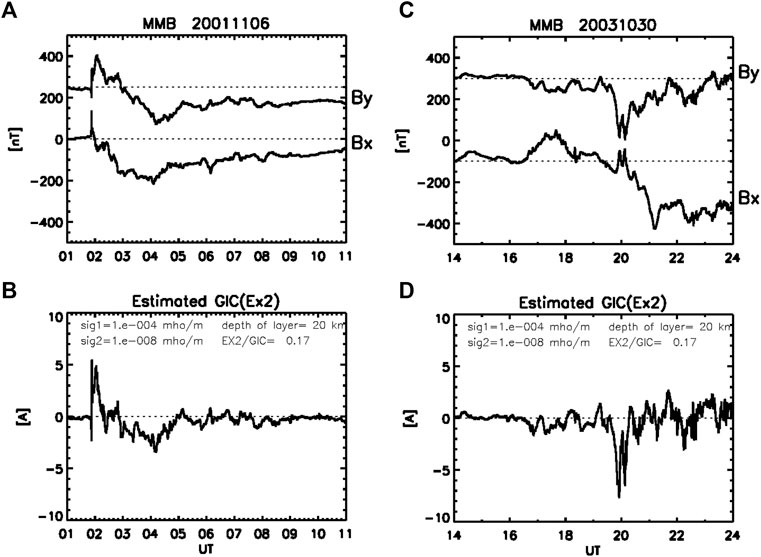
FIGURE 10. (A) Geomagnetic storms recorded at MMB in the daytime (01-09 UT, 10-18 MLT) on November 06, 2001 and (B) in the midnight-morning (16-24 UT, 01-09 MLT) on October 30, 2003. (C) (D) GICs estimated from Ex2 with the scale factor same as in Figures 8, 9.
The parameters used in the two-layer model may not represent the ones estimated by the MT method (Fujii et al., 2015), but the excellent correlations in Table 1 allow us to use the model to reproduce the GIC from the observed magnetic field disturbances. Therefore, the model should be referred to as an empirical model that works for MMB. Although the model is not a commonly applicable model, we check the model with GICs measured at the Shin-Yamaguchi (SYG) substation of the Chugoku Electric Power Company in Yamaguchi prefecture in the western-southern part of Japan (34.16°N, 131.09°E GR; 25.25°N, 201.67°E GM). The power transmission line extends in the east-west direction along the coastline. Figure 11 shows a DP2 fluctuation event (T = 80 min) observed at Kakioka (KAK, 36.23°N,140.19°E GR; 27.95°N,209.77°E GM) and the GIC at SYG, where the high frequency components are removed by applying the moving average over the window of 10 min. The KAK observatory is separated from SYG by 2.7° in GML, but the GIC is well correlated with the IEF such that cc (GIC-ExI) = 0.85 and cc (GIC-ExII) = 0.87. The model parameters are the same as used in the calculations for MMB except for the depth of the upper layer of the two-layer model being 15 km. Figure 12 shows an SC event with time scales of 1–10 min, where the window for the moving average is 30s. The correlation coefficients are better than those of the DP2 event such that cc (GIC-ExI) = 0.93 and cc (GIC-ExII) = 0.95. The correlation coefficients of the GIC with Bx/EyII are not so good; cc = 0.54/0.14 and 0.27/0.51 for the DP2 and SC events, respectively. It is remarkable that the GIC at SYG is strongly dependent on By/Ex, similarly to the GIC at MMB. Furthermore, there is no big difference between the one- and two-layer models, suggesting us to use the simple one-layer model to estimate the GIC at SYG during the past major storms. Using the models constructed in the present study, we would be able to predict the GIC during space weather disturbances with the aid of the global simulations. Ebihara et al. (2014) successfully reproduced ground magnetic disturbances due to the equatorial electrojet driven by the penetration electric fields during substorms. Furthermore, Tanaka et al. (2020) reproduced magnetic disturbances due to field-aligned currents as well as the ionospheric currents during the SC and substorm.
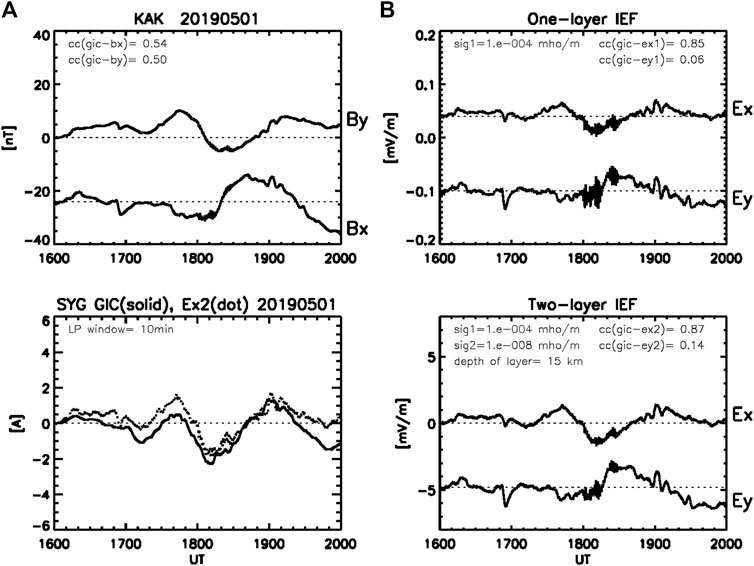
FIGURE 11. (A) Bx and By observed at the Kakioka (KAK) magnetic observatory and GIC observed at the Shin-Yamaguchi (SYG) substation of the Chugoku Electric Power Company during the DP2 fluctuation event with periods of 60–80 min in the early morning (16-20 UT, 01-05 MLT). The GIC data is smoothed by applying the moving average over 10 min. (B) Ex and Ey calculated in one- and two-layer models. The parameters in the frames are the same as in Figure 1 except that the depth of the upper layer of the two-layer model is 15 km.
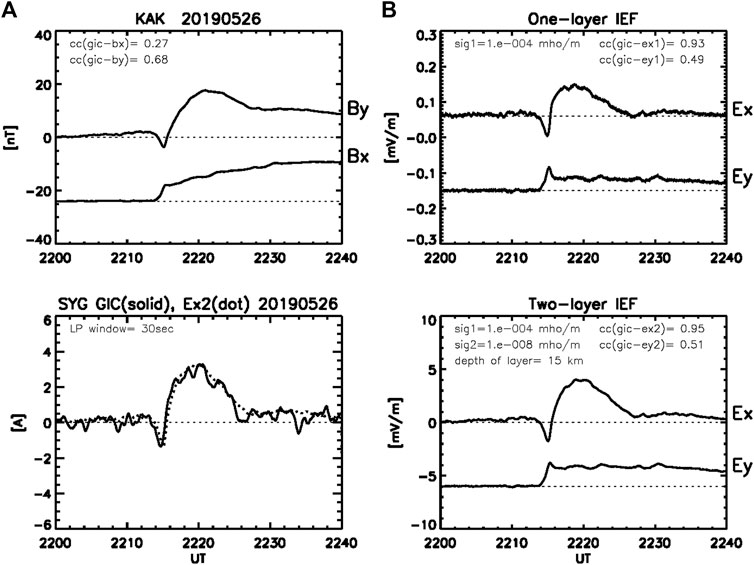
FIGURE 12. (A) Bx and By observed at KAK in the morning (2220 UT, 0720 MLT) and GIC at SYG during the SC event (T = 1–10 min) with the same parameters as in Figure 11, except that the GIC data is smoothed over 30s. (B) IEFs in the same format as in Figure 1.
The power transmission line in Hokkaido is directed southwestward (Watari et al., 2009), which would predict that the GIC is affected equally by both
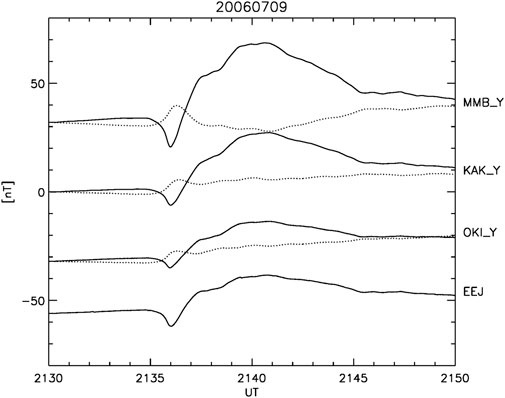
FIGURE 13. Bx (dotted lines) and By (solid lines) recorded during the SC event (Figure 2) at Memambetsu (MMB, 35.7°GML), Kakioka (KAK, 27.8°GML), Okinawa (OKI, 17.0°GML), and the magnetic deflection caused by the equatorial electrojet (EEJ) defined as the difference between Bx (YAP, 0.5°GML) and Bx (OKI). All the stations are in the same local time zone (0630 MLT).
The other possible mechanism is the effects of the geometry such as the direction of power lines and coastlines and of the 3-D structures of Earth’s conductivities (Fujii et al., 2015; Goto, 2015; Nakamura et al., 2018). Ivannikova et al. (2018) found that much of Great Britain was affected by coastal effects owing to the strong conductivity gradient between the land and the ocean. The coastline effects on the GIC are also significant in Hokkaido as deduced from the model calculations (Nakamura et al., 2018). Furthermore, Fujii et al. (2015) clarified that the MT response at Memambetsu shows that By affects the induction in x-direction more strongly than Bx does in y-direction. The MT-deduced anisotropy is explained by means of the spatial inhomogeneity of the Earth’s conductivity. Thus, both effects of the coastline and inhomogeneous distribution of the Earth’s conductivity should have affected the anisotropic response of the GIC to the surface magnetic field. We would need to take into account the inhomogeneous conductivity distribution even in a thin layer model (e.g., McKirdy and Weaver, 1984). However, the horizontally uniform models employed in the present study well explain the GIC-By/Ex correlations. The consistency between the MT and GIC results and the inconsistency between the nonuniform and uniform models remain a question to be addressed in future studies.
Conclusion
1) We have shown that the GIC at Memambetsu in Hokkaido (35.7° GML) is linearly correlated with the y-component geomagnetic field,
2) The induced electric field in the one-layer model with the semi-infinite conductor (
3) We constructed the two-layer model with higher conductivity in the upper layer (
4) The GIC at Shin-Yamaguchi, Japan (25.3° GML) is well correlated with By/ExII similarly to the GIC at MMB, such that cc = 0.87 and 0.95 for the DP2 and SC events, respectively.
5) The strong
Data Availability Statement
The raw data supporting the conclusions of this article will be made available by the authors, without undue reservation.
Author Contributions
TK built the one- and two-layer models and wrote the whole sections of the manuscript. YE contributed to creating the GIC database and to the calculation of the IEF in the models. KKH performed space weather event studies with magnetometer data and contributed to establishing the data acquisition system from SYG substation. KK installed the GIC meter and calibrated the data at SYG. S-IW contributed to recording the GIC at MMB. All authors contributed to manuscript revision, read, and approved the submitted version.
Conflict of Interest
The authors declare that the research was conducted in the absence of any commercial or financial relationships that could be construed as a potential conflict of interest.
Publisher’s Note
All claims expressed in this article are solely those of the authors and do not necessarily represent those of their affiliated organizations, or those of the publisher, the editors and the reviewers. Any product that may be evaluated in this article, or claim that may be made by its manufacturer, is not guaranteed or endorsed by the publisher.
Acknowledgments
The measurement of the GIC at Memambetsu substation of the Hokkaido Electric Power Co., Inc., was carried out under contract with the National Institute of Information and Communications Technology (NICT) and Institute for Sun-Earth Environmental Research (ISEE), Nagoya University. This contract is subject to the data sharing restrictions defined under the Memorandum of Understanding signed by the four organizations, including the NICT (S-IW) and Nagoya University (TK). We would like to thank Mr. Yuji Watanabe, Research and Development Department, the Hokkaido Electric Power Co., Inc., for supporting the GIC measurement at Memambetsu substation. The measurement of the GIC at Shin-Yamaguchi substation of the Chugoku Electric Power Co., Inc. was carried out under contract with the National Institute of Technology/Tokuyama College (TCT) and Kibi International University (KIUI). This contract is subject to the data sharing restrictions defined under the Memorandum of Understanding signed by the three organizations, including the TCT (KK) and KIUI (K.KH). We would like to thank Mr. K. Fujii at the Chugoku Electric Power Co., Inc., for supporting the GIC measurement at the Shin-Yamaguchi substation. Those who are interested in the data may contact with any one of TK at ISEE (a2lrdWNoaUBpc2VlLm5hZ295YS11LmFjLmpw), S-IW at NICT (d2F0YXJpQG5pY3QuZ28uanA=), and K.KH (aGFzaGlAa2l1aS5hYy5qcA==). The magnetometer data at Memambetsu and Kakioka are provided by the Kakioka Magnetic Observatory of the Japan Meteorological Agency (www.kakioka-jma.go.jp). The magnetometer data at Yap and Okinawa are from the Space Weather Magnetometer Network of the NICT. This study is supported by the grants-in-aid for Scientific Research (15H05815, 20H01960) of Japan Society for the Promotion of Science (JSPS), Electric Technology Research Foundation of Chugoku, and Wesco Scientific Promotion Foundation. The works of T.K. are supported by the joint research programs of the Institute for Space-Earth Environmental Research, Nagoya University and the Research Institute for Sustainable Humanosphere, Kyoto University.
References
Akasofu, S.-I. (1964). The Development of the Auroral Substorm. Planet. Space Sci. 12, 273–282. doi:10.1016/0032-0633(64)90151-5
Araki, T. (1977). Global Structure of Geomagnetic Sudden Commencements. Planet. Space Sci. 25, 373–384. doi:10.1016/0032-0633(77)90053-8
Bolduc, L. (2002). GIC Observations and Studies in the Hydro-Québec Power System. J. Atmos. Solar-Terrestrial Phys. 64, 1793–1802. doi:10.1016/s1364-6826(02)00128-1
Borovsky, J. E., and Yakymenko, K. (2017). Substorm Occurrence Rates, Substorm Recurrence Times, and Solar Wind Structure. J. Geophys. Res. Space Phys. 122, 2973–2998. doi:10.1002/2016JA023625
Boteler, D. H., and Pirjola, R. J. (1998). The Complex-Image Method for Calculating the Magnetic and Electric fields Produced at the Surface of the Earth by the Auroral Electrojet. Geophys. J. Int. 132, 31–40.
Brändlein, D., Lühr, H., and Ritter, O. (2012). Direct Penetration of the Interplanetary Electric Field to Low Geomagnetic Latitudes and its Effect on Magnetotelluric Sounding. J. Geophys. Res. 117. doi:10.1029/2012JA018008
Cagniard, L. (1953). Basic Theory of the Magneto‐telluric Method of Geophysical Prospecting. Geophysics 18 (3), 605–635. doi:10.1190/1.1437915
Carter, B. A., Yizengaw, E., Pradipta, R., Weygand, J. M., Piersanti, M., Pulkkinen, A., et al. (2016). Geomagnetically Induced Currents Around the World during the 17 March 2015 Storm. J. Geophys. Res. Space Phys. 121. doi:10.1002/2016JA023344
Ebihara, Y., Tanaka, T., and Kikuchi, T. (2014). Counter Equatorial Electrojet and Overshielding after Substorm Onset: Global MHD Simulation Study. J. Geophys. Res. Space Phys. 119, 7281–7296. doi:10.1002/2014JA020065
Freeman, M. P., and Morley, S. K. (2004). A Minimal Substorm Model that Explains the Observed Statistical Distribution of Times between Substorms. Geophys. Res. Lett. 31. doi:10.1029/2004GL019989
Fujii, I., Ookawa, T., Nagamachi, S., and Owada, T. (2015). The Characteristics of Geoelectric fields at Kakioka, Kanoya, and Memambetsu Inferred from Voltage Measurements during 2000 to 2011. Earth Planet. Sp. 67, 62. doi:10.1186/s40623-015-0241-z
Goto, T.-n. (2015). Numerical Studies of Geomagnetically Induced Electric Field on Seafloor and Near Coastal Zones Incorporated with Heterogeneous Conductivity Distributions. Earth Planet. Sp. 67, 193. doi:10.1186/s40623-015-0356-2
Han, D.-S., Iyemori, T., Nose, M., McCreadie, H., Gao, Y., Yang, F., et al. (2004). A Comparative Analysis of Low-Latitude Pi2 Pulsations Observed by Ørsted and Ground Stations. J. Geophys. Res. 109, A10209. doi:10.1029/2004JA010576
Imajo, S., Yoshikawa, A., Uozumi, T., Ohtani, S., Nakamizo, A., Marshall, R., et al. (2015). Pi2 Pulsations Observed Around the Dawn Terminator. J. Geophys. Res. Space Phys. 120, 2088–2098. doi:10.1002/2013JA019691
Ivannikova, E., Kruglyakov, M., Kuvshinov, A., Rastätter, L., and Pulkkinen, A. (2018). Regional 3-D Modeling of Ground Electromagnetic Field Due to Realistic Geomagnetic Disturbances. Space Weather. 16, 476–500. doi:10.1002/2017SW001793
Kikuchi, T., and Araki, T. (1979). Horizontal Transmission of the Polar Electric Field to the Equator. J. Atmos. Terrestrial Phys. 41, 927–936. doi:10.1016/0021-9169(79)90094-1
Kikuchi, T., Araki, T., Maeda, H., and Maekawa, K. (1978). Transmission of Polar Electric fields to the Equator. Nature 273, 650–651. doi:10.1038/273650a0
Kikuchi, T., Lühr, H., Kitamura, T., Saka, O., and Schlegel, K. (1996). Direct Penetration of the Polar Electric Field to the Equator during aDP2 Event as Detected by the Auroral and Equatorial Magnetometer Chains and the EISCAT Radar. J. Geophys. Res. 101, 17161–17173. doi:10.1029/96ja01299
Kikuchi, T. (2014). Transmission Line Model for the Near-Instantaneous Transmission of the Ionospheric Electric Field and Currents to the Equator. J. Geophys. Res. Space Phys. 119, 1131–1156. doi:10.1002/2013JA019515
Kikuchi, T., Tsunomura, S., Hashimoto, K., and Nozaki, K. (2001). Field-aligned Current Effects on Midlatitude Geomagnetic Sudden Commencements. J. Geophys. Res. 106 (15), 555. doi:10.1029/2001ja900030
Kozyreva, O. V., Pilipenko, V. A., Belakhovsky, V. B., and Sakharov, Y. A. (2018). Ground Geomagnetic Field and GIC Response to March 17, 2015, Storm. Earth Planet. Sp. 70, 157. doi:10.1186/s40623-018-0933-2
Love, J. J., and Swidinsky, A. (2014). Time Causal Operational Estimation of Electric fields Induced in the Earth's Lithosphere during Magnetic Storms. Geophys. Res. Lett. 41, 2266–2274. doi:10.1002/2014GL059568
Love, J. J., and Swidinsky, A. (2015). Observatory Geoelectric fields Induced in a Two-Layer Lithosphere during Magnetic Storms. Earth Planet. Sp. 67, 58. doi:10.1186/s40623-015-0213-3
McKirdy, D. M., and Weaver, J. T. (1984). Induction in a Thin Sheet of Variable Conductance at the Surface of a Stratified Earth -- I. Two-Dimensional Theory. Geophys. J. Int. 78, 93–103. doi:10.1111/j.1365-246x.1984.tb06473.x
McPherron, R. L., Russell, C. T., and Aubry, M. P. (1973). Satellite Studies of Magnetospheric Substorms on August 15, 1968: 9. Phenomenological Model for Substorms. J. Geophys. Res. 78 (16), 3131–3149. doi:10.1029/ja078i016p03131
Nakamura, S., Ebihara, Y., Fujita, S., Goto, T., Yamada, N., Watari, S., et al. (2018). Time Domain Simulation of Geomagnetically Induced Current (GIC) Flowing in 500‐kV Power Grid in Japan Including a Three‐Dimensional Ground Inhomogeneity. Space Weather. 16, 1946–1959. doi:10.1029/2018SW002004
Ngwira, C. M., Pulkkinen, A., Wilder, F. D., and Crowley, G. (2013). Extended Study of Extreme Geoelectric Field Event Scenarios for Geomagnetically Induced Current Applications. Space Weather. 11, 121–131. doi:10.1002/swe.20021
Owada, S. (1972). On the Subterranean Electric Conductivity Near Memambetsu Deduced by the Magneto-Telluric Method (Japanese with English Abstract). Mem. Kakioka Magn. Observatory. 14 (No.2), 77–85.
Pirjola, R. (2010). Derivation of Characteristics of the Relation between Geomagnetic and Geoelectric Variation fields from the Surface Impedance for a Two-Layer Earth. Earth Planet. Sp. 62, 287–295. doi:10.5047/eps.2009.09.002
Pirjola, R. (2000). Geomagnetically Induced Currents during Magnetic Storms. IEEE Trans. Plasma Sci. 28 (6), 1867–1873. doi:10.1109/27.902215
Pirjola, R. (1983). Induction in Power Transmission Lines during Geomagnetic Disturbances. Space Sci. Rev. 35, 185–193. doi:10.1007/978-94-009-7063-2_14
Pulkkinen, A., Kataoka, R., Watari, S., and Ichiki, M. (2010). Modeling Geomagnetically Induced Currents in Hokkaido, Japan. Adv. Space Res. 46, 1087–1093. doi:10.1016/j.asr.2010.05.024
Pulkkinen, A., Pirjola, R., and Viljanen, A. (2007). Determination of Ground Conductivity and System Parameters for Optimal Modeling of Geomagnetically Induced Current Flow in Technological Systems. Earth Planet. Sp. 59, 999–1006. doi:10.1186/bf03352040
Ritter, P., and Lühr, H. (2008). Near-Earth Magnetic Signature of Magnetospheric Substorms and an Improved Substorm Current Model. Ann. Geophys. 26, 2781–2793. Available at: www.ann-geophys.net/26/2781/2008/. doi:10.5194/angeo-26-2781-2008
Satoh, H., Nishida, Y., Ogawa, Y., Takada, M., and Uyeshima, M. (2001). Crust and Upper Mantle Resistivity Structure in the Southwestern End of the Kuril Arc as Revealed by the Joint Analysis of Conventional MT and Network MT Data. Earth Planet. Sp 53, 829–842. doi:10.1186/BF03351680
Sutcliffe, P. R., and Lühr, H. (2010). A Search for Dayside Geomagnetic Pi2 Pulsations in the CHAMP Low-Earth-Orbit Data. J. Geophys. Res. 115. doi:10.1029/2009JA014757
Sutcliffe, P. R., and Lyons, L. R. (2002). Association between Quiet-Time Pi2 Pulsations, Poleward Boundary Intensifications, and Plasma Sheet Particle Fluxes. Geophys. Res. Lett. 29 (9), 7–1. doi:10.1029/2001gl014430
Tanaka, T., Ebihara, Y., Watanabe, M., Den, M., Fujita, S., Kikuchi, T., et al. (2020). Reproduction of Ground Magnetic Variations during the SC and the Substorm from the Global Simulation and Biot‐Savart's Law. J. Geophys. Res. Space Phys. 125, e2019JA027172. doi:10.1029/2019ja027172
Trichtchenko, L., and Boteler, D. (2006). Response of Power Systems to the Temporal Characteristics of Geomagnetic Storms. Can. Conf. Electr. Comp. Eng. doi:10.1109/CCECE.2006.277733
Uyeshima, M. (2007). EM Monitoring of Crustal Processes Including the Use of the Network-MT Observations. Surv. Geophys. 28, 199–237. doi:10.1007/s10712-007-9023-x
Uyeshima, M., Utada, H., and Nishida, Y. (2001). Network-magnetotelluric Method and its First Results in central and Eastern Hokkaido, NE Japan. J. Int. 146, 1–19. doi:10.1046/j.0956-540x.2001.01410.x
Viljanen, A., and Pirjola, R. (1989). Statistics on Geomagnetically-Induced Currents in the Finnish 400kV Power System Based on Recordings of Geomagnetic Variations. J. Geomagn. Geoelec. 41, 411–420. doi:10.5636/jgg.41.411
Viljanen, A., Pirjola, R., Wik, M., Ádám, A., Prácser, E., Sakharov, Y., et al. (2012). Continental Scale Modelling of Geomagnetically Induced Currents. J. Space Weather Space Clim. 2, A17. doi:10.1051/swsc/2012017
Viljanen, A. (1997). The Relation between Geomagnetic Variations and Their Time Derivatives and Implications for Estimation of Induction Risks. Geophys. Res. Lett. 24, 631–634. doi:10.1029/97gl00538
Watari, S., Kunitake, M., Kitamura, K., Hori, T., Kikuchi, T., Shiokawa, K., et al. (2009). Measurements of Geomagnetically Induced Current in a Power Grid in Hokkaido, Japan. Space Weather 7. doi:10.1029/2008SW000417
Keywords: geomagnetically induced current (GIC), middle latitude, polar-equatorial ionospheric currents, TM0 mode in the earth-ionosphere waveguide, induced electric field in the two-layer conductivity model, geomagnetic by dependence of GIC
Citation: Kikuchi T, Ebihara Y, Hashimoto KK, Kitamura K and Watari S-I (2021) Reproducibility of the Geomagnetically Induced Currents at Middle Latitudes During Space Weather Disturbances. Front. Astron. Space Sci. 8:759431. doi: 10.3389/fspas.2021.759431
Received: 16 August 2021; Accepted: 02 September 2021;
Published: 11 October 2021.
Edited by:
Toshi Nishimura, Boston University, United StatesReviewed by:
Larry Lyons, UCLA Atmospheric and Oceanic Sciences, United StatesHermann Lühr, German Research Centre for Geosciences, Germany
Copyright © 2021 Kikuchi, Ebihara, Hashimoto, Kitamura and Watari. This is an open-access article distributed under the terms of the Creative Commons Attribution License (CC BY). The use, distribution or reproduction in other forums is permitted, provided the original author(s) and the copyright owner(s) are credited and that the original publication in this journal is cited, in accordance with accepted academic practice. No use, distribution or reproduction is permitted which does not comply with these terms.
*Correspondence: Takashi Kikuchi, a2lrdWNoaUBpc2VlLm5hZ295YS11LmFjLmpw
 Takashi Kikuchi
Takashi Kikuchi Yusuke Ebihara
Yusuke Ebihara Kumiko. K. Hashimoto3
Kumiko. K. Hashimoto3